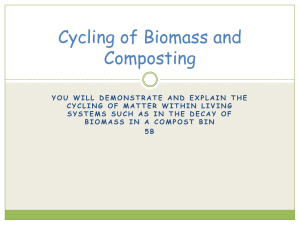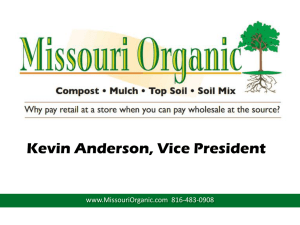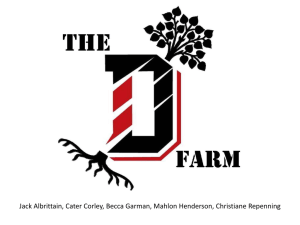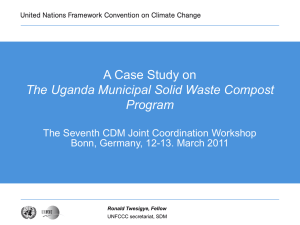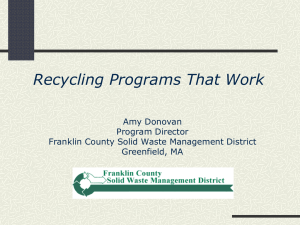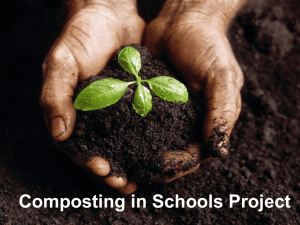Project Submittal Form - Green Giant Venture Fund
advertisement
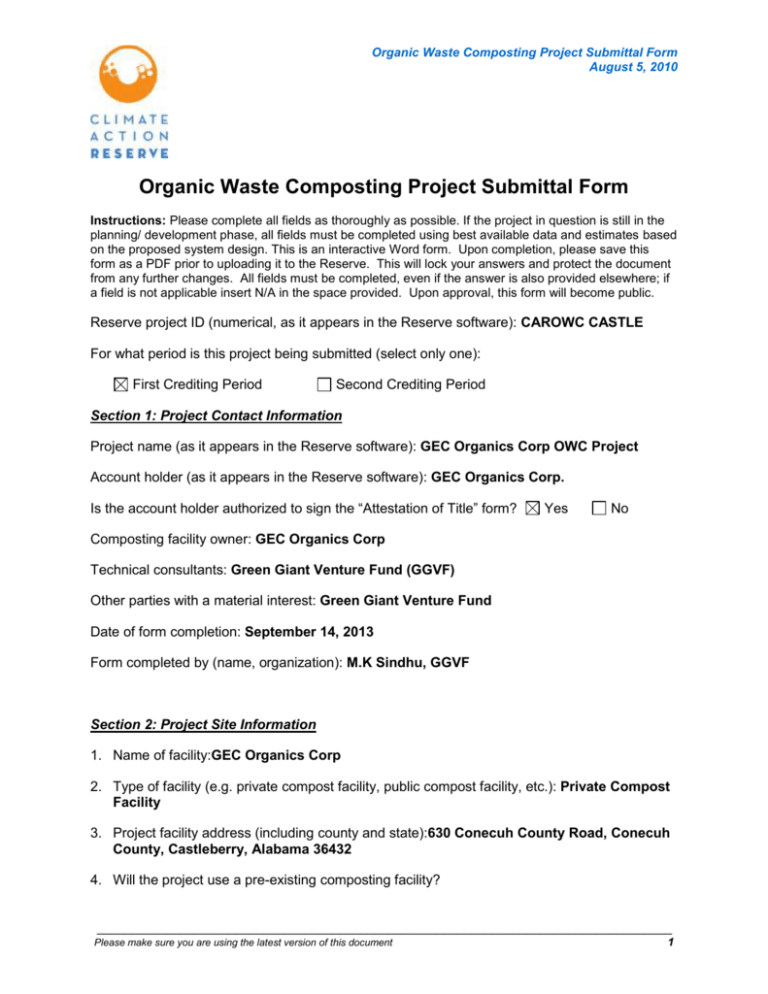
Organic Waste Composting Project Submittal Form August 5, 2010 Organic Waste Composting Project Submittal Form Instructions: Please complete all fields as thoroughly as possible. If the project in question is still in the planning/ development phase, all fields must be completed using best available data and estimates based on the proposed system design. This is an interactive Word form. Upon completion, please save this form as a PDF prior to uploading it to the Reserve. This will lock your answers and protect the document from any further changes. All fields must be completed, even if the answer is also provided elsewhere; if a field is not applicable insert N/A in the space provided. Upon approval, this form will become public. Reserve project ID (numerical, as it appears in the Reserve software): CAROWC CASTLE For what period is this project being submitted (select only one): First Crediting Period Second Crediting Period Section 1: Project Contact Information Project name (as it appears in the Reserve software): GEC Organics Corp OWC Project Account holder (as it appears in the Reserve software): GEC Organics Corp. Is the account holder authorized to sign the “Attestation of Title” form? Yes No Composting facility owner: GEC Organics Corp Technical consultants: Green Giant Venture Fund (GGVF) Other parties with a material interest: Green Giant Venture Fund Date of form completion: September 14, 2013 Form completed by (name, organization): M.K Sindhu, GGVF Section 2: Project Site Information 1. Name of facility:GEC Organics Corp 2. Type of facility (e.g. private compost facility, public compost facility, etc.): Private Compost Facility 3. Project facility address (including county and state):630 Conecuh County Road, Conecuh County, Castleberry, Alabama 36432 4. Will the project use a pre-existing composting facility? ___________________________________________________________________________________ Please make sure you are using the latest version of this document 1 Climate Action Reserve – Organic Waste Composting Project Submittal Form August 5, 2011 Yes No If yes: a. Does the system have excess capacity for composting eligible waste streams?: Yes No 5. Total waste processing capacity (MT per day): 500 6. Estimated food and soiled paper waste capacity (MT per day): Food Waste, 250 when this process is started. The facility at present is only processing chicken manure and green waste. No paper products are being considered at this time. 7. Describe the facility’s waste handling and mixing procedures and equipment (prior to composting activities): Prior to the composting activities at the project site, chicken manure is delivered to the site and staged on a concrete pad. The waste is immediately treated with our blend of dominate microbes by spraying and the process of decontamination is begun. Wood chips are also delivered and set in a pile before being distributed for composting. a. Maximum length of time between waste delivery and waste control (i.e. incorporated into composting process, covered with high-carbon materials, or placed in a controlled environment): 3 to 5 Days 8. Describe the type(s) of material used as bulking agents, and the approximate initial C:N ratio of the compost mix: The bulking agents for the current process is natural, untreated wood shavings. The C/N ratio is 25:1 9. Composting activities: a. Type of composting system: Forced Aeration Turned Windrow Other (describe) Turned Windrow by Scarab Windrow Turner. b. Description of composting activities (including types of materials and technologies employed): The all organic, USDA certified, Compost we produce is a combination of green waste ( wood shavings) and chicken manure. Our current ratio is 1 part green waste to 2 parts chicken manure. The combination of material is distributed on a windrow 12 feet wide and from 800 to 1000 feet in length. During the turning process ( see below ) our proprietary blend of microbes is sprayed on the windrow. c. Temperature of compost during active composting:160 degrees d. Length of active composting period: From 30 to 45 days depending on weather ( temperature, rain, etc.) e. For windrows, number of turns during active composting period: Each windrow is turned 3 to 4 times per week. ___________________________________________________________________________________ Please make sure you are using the latest version of this document 2 Climate Action Reserve – Organic Waste Composting Project Submittal Form August 5, 2011 10. Description of the storage of final compost material:After the composting process as described in #9,a, b ,c,d and e is complete, the composted material is moved to a staging pile where it is allowed to sit until it reaches the approximate ambient temperature. The material is then sifted to a fine grade so it can easily be broadcasted through a commercial spreader. Any of the original wood shavings which have not been degraded enough fall away from the sifting machine and are redistributed in windrows being processed with new raw material. Section 3: Project Eligibility and Monitoring 11. Version of the Organic Waste Composting Project Protocol under which this project is being submitted: OWC 12. Project description (Please provide one to two paragraphs): The Castleberry OWC project is developed by Green Giant Venture Fund/Grant Galloway (hereafter referred as the project developer) at 630 Conecuh County Road, Castleberry, Alabama,36432 USA . The project applies anaerobic digestion technology to dispose 500 tons of organic waste per day. 13. The composting technology is applied as well to dispose 500 TPD of chicken manure and green waste. The output from composting will be used to produce organic fertilizer. The Castleberry OWC project goal is to help farmers dramatically improve the quality and health of their soil and crops, while reducing their dependency on synthetic fertilizers! 14. 15. Project start date (format MM/DD/YYYY):October 01, 2013 16. First reporting period (MM/DD/YYYY):TBA to TBA 17. Have any GHG reductions from the project ever been registered with or claimed by another registry or program prior to registering with the Reserve? No If the answer is yes, you must complete and return a "Project Transfer" form. 18. Have any GHG reductions from the project ever been sold directly to a third party (i.e. sold without being registered with or claimed by another registry or program) prior to registering with the Reserve? No If the answer is yes, please describe: 19. As of the project start date, is/was the composting facility in compliance with the Best Management Practices (BMPs) defined in Sections 2.2 and 6.3 of the protocol (including time, temperature and turning frequency, waste handling requirements, and other monitoring requirements)? Yes 20. Has a detailed monitoring plan been developed for this project? If not, by what date will a monitoring plan be in place? Yes ___________________________________________________________________________________ Please make sure you are using the latest version of this document 3 Climate Action Reserve – Organic Waste Composting Project Submittal Form August 5, 2011 21. Eligible waste stream information: a. Description of the eligible waste stream(s) that the project will compost: Food Waste as contemplated in the future. No paper products b. Approximate anticipated quantity of non-industrial food waste and/or soiled paper waste to be composted (MT wet waste per day): 250 c. County or counties of origin of non-industrial food waste and/or soiled paper waste streams: USA d. Waste delivered as (check all that apply): Source separated organics: Non-source separated organics: Residential Previously mixed solid waste (separated off-site) Commercial Mixed solid waste (separated on-site) Grocery store Other (describe): Other (describe): Poultry Farm Waste 22. Non-eligible waste stream information: a. Description of any non-eligible waste materials composted at the project compost facility: N/A b. Prior to the project start date, did the project composting facility compost food waste originating from grocery stores or supermarkets? Yes No If yes, what was the approximate tonnage (MT) of grocery store and supermarket food waste composted at the facility in the 12 months preceding the project start date? 23. Description and citation of all local and state air and water quality or other regulations pertinent to the project: The project is developed according to the Alabama Department of Environmental Management (ADEM) regulations and the federal environmental protection laws through regulations governing air pollution, water quality and supply, solid and hazardous waste management. http://web.ead.anl.gov/dwm/regs/state/alabama/index.cfm, http://www.adem.state.al.us/compInfo/default.cnt 24. Provide a summary of the permits obtained to compost food waste at the facility: N/A 25. Is the project being implemented as the result of any law, statute, regulation, court order, or other preexisting legally binding mandate? ___________________________________________________________________________________ Please make sure you are using the latest version of this document 4 Climate Action Reserve – Organic Waste Composting Project Submittal Form August 5, 2011 Yes No If yes, please explain. 26. Are there any laws, statutes, regulations, court orders, or other preexisting legally binding mandates requiring the diversion, digestion, or composting of any waste streams that will be composted by the project? Yes No If yes, please explain. 27. Additional information (if any): End of form ___________________________________________________________________________________ Please make sure you are using the latest version of this document 5

